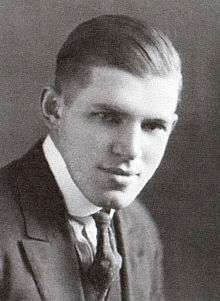John Augustus Larson
John Augustus Larson (11 December 1892 – 1 October 1965) was a Police Officer for Berkeley, California, United States, and famous for his invention of modern polygraph used in forensic investigations.[1] He was the first American police officer having an academic doctorate and to use polygraph in criminal investigations.[2][3] After a famed career in criminal investigation, he died of a heart attack in Nashville, Tennessee at the age of 72.[4]
John Augustus Larson | |
|---|---|
 John Larson in 1921 | |
| Born | December 11, 1892 |
| Died | October 1, 1965 (aged 72) |
| Nationality | American |
| Citizenship | U.S. |
| Education | Boston University (M.Sc., 1915) University of California, Berkeley (Ph.D., 1920) |
| Alma mater | University of California, Berkeley |
| Known for | Criminology, Polygraphy |
| Scientific career | |
| Fields | Medicine Criminology |
Early life and career
Larson was born in Shelburne, Nova Scotia, Canada, to Nordic parents. His family moved to New England in his early childhood, though his parents soon divorced. He studied biology at Boston University holding down odd jobs to support himself, ranging from busboy and paperboy to stonecutter and elevator operator. In 1915, he earned a master's degree with a thesis on fingerprint identification. This work inspired his interest in forensic science and led him to the University of California, Berkeley, where he obtained a Ph.D. in physiology in 1920.[5]
Having done moonlighting work as a student for the Berkeley Police Department, he joined the force in 1920. His great insight was to integrate a test for blood pressure, developed by William Moulton Marston, with measurements for pulse, respiration and skin conductivity, to make a comprehensive lie detection tool. He was also highly encouraged by his police chief August Vollmer.
At the time of the invention of the polygraph, Larson was a 21-year-old medical student at the University of California, Berkeley. He later entered the field of forensic psychiatry.
Invention of polygraph
The instrument, with its diverse collection of physiological indices, became known as the polygraph, which Larson then fully developed for forensic use in 1921, and applied it in police investigations at the Berkeley Police Department.[6][7] His instrument provided continuous readings of blood pressure, rather than discontinuous readings of the sort found in Marston's device. The first practical use was in the summer of 1921. The San Francisco Call and Post arranged for Larson to use the apparatus to test William Hightower, accused of murdering a priest in San Francisco. The newspaper reported Larson’s findings the following morning: Hightower was pronounced guilty by impartial science. The graphic results of the interrogation were printed large across the page, with arrows marking each presumed lie. Vollmer exalted the machine to the press, which renamed it the 'lie detector.' However, Larson himself used to refer to his apparatus as a 'cardio-pneumo psychogram,' which basically consisted of a modification of an Erlanger Sphygmomanometer.[8]
Legacy
Larson married Margaret Taylor, the freshman victim of the College Hall case and the first person he ever interrogated on the lie detector. Over the next fifteen years, he collected hundreds of files on successful criminal cases where his polygraph solved murders, robberies, thefts and sex crimes. His instrument was nicknamed 'Sphyggy' by the press who covered Larson’s crime solving escapades in the 1920s and 30's; Sphyggy because they couldn’t pronounce 'Sphygmomanometer.' [9]
The polygraph is included in the Encyclopædia Britannica Almanac 2003's list of 325 greatest inventions.[10] This first polygraph instrument of Larson is now at the Smithsonian Institution in Washington, D.C.. It first appeared in action in a moving picture in 1926 in the silent police serial ‘’Officer 444’’.
Due to differing methods of using his device that Larson felt were incorrect and abusive by some law enforcement, he eventually came to regret having invented it.[11]
Bibliography
- The cardio-pneumo-psychogram in deception. Phillips Bros., Print (1924)
- Single fingerprint system, (The Berkeley police monograph series). D. Appleton (1924)
- The use of the polygraph in the study of deception at the Institute of Juvenile Research, Chicago. Dept. of Public Welfare (1927)
- Lying and its detection: A study of deception and deception tests (Behavior research fund. Monographs). The University of Chicago press (1932)
- Truth in the Machine E. Carlson, Cal Alumni Association, UC Berkeley (2010)
See also
References
- Bellis, M. Police Technology and Forensic Science: History of the Lie Detector or Polygraph Machine.About.com Inventors.
- Carlsen E (2010). Truth in the machine. California Magazine, Cal Alumni Association, Berkeley
- Gordon, N. J. (2008). Today's Instruments for Truth Testing. The Police Chief, vol. 75, no. 9.
- Milestones on Time magazine
- Alder, K (2007). The Lie Detectors: The History of an American Obsession. Free Press, Simon and Schuster, Inc, pp. 23-25. ISBN 0-7432-5988-2
- Matté, J A (1996). Forensic psychophysiology using the polygraph: scientific truth verification, lie detection. J.A.M. Publications, p. 22. ISBN 0-9655794-0-9
- Segrave, K (2004). Lie detectors: a social history. McFarland, pp. 18-19. ISBN 0-7864-1618-1
- The Polygraph Museum John Larson's Breadboard Polygraph
- John Larson’s California
- "Greatest Inventions of All Time". i-dineout.com. 2002. Retrieved 23 March 2019.
- "Truth in the Machine". Cal Alumni Association. 2010-03-16. Retrieved 2019-01-18.